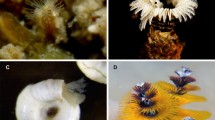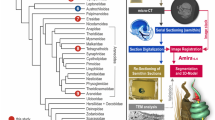Summary
In several genera of Uloborid spiders the median spinnerets are provided with a cluster of specialized spools. These spools are comparable in structure with those of the cribellum, but far fewer in number. We name the newly described formation of spools the paracribellum. The histological features of the associated glands are similar to those of the cribellar glands; histochemically they seem closer to the pseudoflagelliform glands. It is suggested that paracribellar fibers impart consistency to the fibrillar secretion of the cribellum.
Similar content being viewed by others
E. Références
Akerman C (1926) On the spider Menneus camelus Pocock which constructs a moth catching expanding snare. Ann Natal Mus 5:411–422
Anatasiu-Dumitresco M (1941) Contributions à l'étude anatomique et cytologique de l'appareil séricigène des Araignées. lère partie. Anal Acad Rom Mem Sect Stiint, Ser III 16:773–840
Berland J (1916) Note préliminaire sur le cribellum et le calamistrum des Araignées Cribellates et sur les moeurs de ces araignées. Arch Zool Exp Gen 55:53–66
Bristowe WS (1958) The World of Spiders. Collins, London, p 304
Comstock JH (1912) The Spider Book. Doubleday, Doran and Co, New York, pp 1–729
Eberhard WG (1972) The web of Uloborus diversus. J Zool London 166:417–465
Eberhard WG (1973) Stabilimenta on the webs of Uloborus diversus (Araneae: Uloboridae) and other spiders. J Zool London 171:367–384
Eberhard WG (1976) Physical properties of sticky spirals and their connections in orb webs. J Nat Hist 10:481–488
Eberhard WG (1977) The webs of newly emerged Uloborus diversus and of a male Uloborus sp. (Araneae: Uloboridae). J Arachnol 4:201–206
Foelix RF, Jung H (1978) Some anatomical aspects of Hypochilus thorelli with special reference to the calamistrum and cribellum. Symp Zool Soc London 42:417–422
Friedrich VL, Langer RM (1969) Fine structure of cribellate spider silk. Am Zool 9:91–96
Gabe M (1968) Techniques histologiques. Masson, Paris, pp 1–1113
Gabe M (1976) Histological Techniques. Springer, New York. Masson, Paris, p 1106
Kovoor J (1972) Etude histochimique et cytologique des glandes séricigènes de quelques Argiopidae. Ann Sci Nat Zool, Sér 12e 14:1–40
Kovoor J (1977a) La soie et les glandes séricigènes des Arachnides. Année Biol 16:97–171
Kovoor J (1977b) L'appareil séricigène dans le genre Uloborus Latr. (Araneae, Uloboridae). I. Anatomie. Rev Arachnol 1:89–102
Kovoor J (1978) L'appareil séricigène dans le genre Uloborus Latr. (Araneae, Uloboridae). II. Données histochimiques. Ann Sci Nat Zool, Sér 12e 20:3–25
Kovoor J, Lopez A (1979) Présence de glandes à soie mélanisées chez des Erisidae solitaires (Araneae). Rev Arachnol 2:89–102
Kullmann E (1968) Das Cribellum zweier Stegodyphus-Arten im elektronenoptischen Bild (Arachnida: Araneae: Eresidae). Senckenberg Biol 49:451–460
Kullmann E (1969) Spinnorgan mit 40000 ‘Düsen’. Umschau Wiss Tech 3:82–83
Kullmann E (1970/1971) Bemerkenswerte Konvergenzen im Verhalten cribellater und ecribellater Spinnen. Z Kölner Zoo 13:123–150
Kullmann E (1972) The convergent development of orb-webs in cribellate and ecribellate spiders. Am Zool 12:395–407
Kullmann E (1975) Netze in Natur und Technik. IL 8, Univ Stuttgart
Langer RM, Eberhard W (1969) Laboratory photography of spider webs. Am Zool 9:97–101
Lehmensick R, Kullmann E (1956) Über den Feinbau der Fäden einiger Spinnen (Vergleich des Aufbaues der Fangfäden cribellater und ecribellater Spinnen). Zool Anz Suppl 20:123–129
Lillie RD, Fullmer HM (1976) Histopathologic technic and practical histochemistry. Mc Graw-Hill Book Comp, New-York, pp 1–942
Lubin YD, Eberhard WG, Montgomery GG (1978) The single-line web of Miagrammopes (Uloboridae). Psyche 85:1–23
Opell BD (1979) Revision of the genera and tropical american species of the family Uloboridae. Bull Mus Comp Zool Harvard 148:433–549
Peters HM (1953) Beiträge zur vergleichenden Ethologie und Ökologie tropischer Webespinnen. Z Morphol Ökol Tiere 42:278–306
Szlep R (1961) Developmental changes in the web spinning instinct of Uloboridae: construction of the primary-type web. Behaviour 17:60–70
Wiehle H (1927) Beiträge zur Kenntnis des Radnetzbaues der Epeiriden, Tetragnathiden und Uloboriden. Z Morphol Ökol Tiere 8:468–537
Wiehle H (1931) Neue Beiträge zur Kenntnis des Fanggewebes der Spinnen aus den Familien Argiopidae, Uloboridae und Theridiidae. Z Morphol Ökol Tiere 22:349–400
Author information
Authors and Affiliations
Rights and permissions
About this article
Cite this article
Peters, H.M., Kovoor, J. Un complément à l'appareil séricigène des Uloboridae (Araneae): Le paracribellum et ses glandes. Zoomorphology 96, 91–102 (1980). https://doi.org/10.1007/BF00310079
Received:
Issue Date:
DOI: https://doi.org/10.1007/BF00310079




